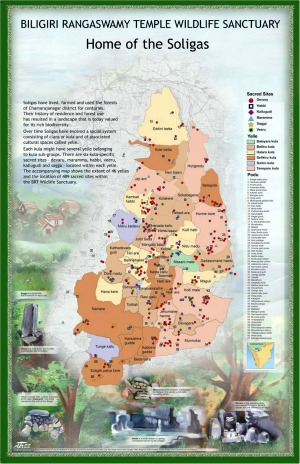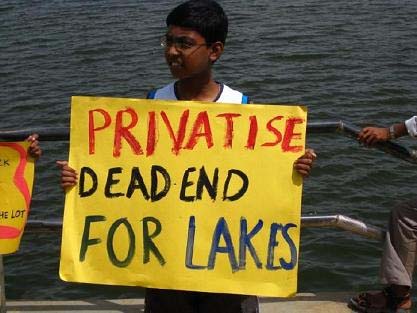News and Articles
Water quality hot-spots in rivers of India: Comments by South Asia Network on Dams, Rivers & People, New Delhi
Posted on 30 Nov, 2011 04:54 PMThe Central Water Commission (CWC) has recently prepared a report on water quality scenario of our rivers and has evolved a methodology for identifying hot spots in Indian rivers. The water quality data is based on the average values observed during the last ten years (2001-2011) at 371 monitoring stations of CWC on almost all major, medium and minor rivers in India. Please find below a letter (dated November 5, 2011) from South Asia Network on Dams, Rivers & People, New Delhi to the Chairman, Central Water Commission stating its concerns regarding the report.
Trouble in Tigerland: Why conservation efforts continue to fail
Posted on 30 Nov, 2011 11:53 AMGuest Post: Nitin Rai, Ashoka Trust for Research in Ecology and the Environment (ATREE)
Drawing upon his experience working with the Soligas who live within the Biligiri Rangaswamy Temple Wildlife Sanctuary, Nitin Rai talks about the ‘wilderness’ myth and explores the origins and impacts of the belief that people and animals cannot co-exist.

Karnataka High Court Committee strongly discourages commercial involvement in lake management and rejuvenation
Posted on 23 Nov, 2011 03:57 PMContent and photo courtesy: Environment Support Group
On the contentious policy relating to privatization of lakes, the Justice N K Patil Committee appointed by the Karnataka High Court has recommended that private sector participation solely based on commercial interest is not desirable.

In a significant development, the Committee appointed under the Chairmanship of Justice Mr. N. K. Patil, Judge of the Karnataka High Court and Chairman High Court Legal Services Committee, in response to the Public Interest Litigation by Environment Support Group challenging the privatisation of management and rehabilitation of lakes in Bangalore (WP 817/2008), has strongly recommended that ““private sector participation solely based on consequential commercial interest” is not a desirable model” (Emphasis in original).
Gravity based spring water supply systems in Andhra Pradesh: Lessons and steps towards the future
Posted on 22 Nov, 2011 07:35 AMGuest post by – Rahul Bakare, Arghyam
This article details an example where local knowledge has been used to develop access to safe water in the tribal areas of the Eastern Ghats in Andhra Pradesh
Northeast monsoon causes floods in parts of Tamil Nadu and Kerala, some snowfall in Kashmir: News Roundup (01 to 15 November 2011)
Posted on 22 Nov, 2011 07:26 AMThe news this fortnight has been dominated by the north-east monsoon in South India, mainly in Tamil Nadu and Kerala. Periyar, Vagai, Krishnarajasagar, Mettur and Chemberampakkam reservoirs have either reached full capacity or are expected to in the next few days. Areas downstream of Vagai reservoir received flood warnings.
In the cities of Tamil Nadu, heavy rains and inadequate infrastructure have led to damage to life and property, with 10 people dead in two separate incidents.
Winter precipitation has begun in Kashmir, with the higher reaches receiving snowfall.
Demonstration cum dissemination of the feasibility of KAF (Kanchan Arsenic Filter) in Assam - A workshop report - IGSSS and Welthungerhilfe (26th July 2011)
Posted on 21 Nov, 2011 10:26 AMThe workshop aimed at possible replication and acceptability of KAF as a viable, low cost appropriate arsenic mitigation measure in the arsenic contaminated regions of the country.
Creation of a village spring atlas for the conservation of Himalayan springs and adapting to climate change
Posted on 18 Nov, 2011 11:52 AMImage courtesy: http://sikkimsprings.org/
Living rivers, dying rivers: Rivers in North East India
Posted on 15 Nov, 2011 03:29 PMRivers in North-East India

Rainwater Harvesting Users and Trainers' Manual by the KUIDFC
Posted on 10 Nov, 2011 12:03 PMAdequate potable water supply to the community has become an uphill task to the administration both in rural and urban areas. This is because of dwindling groundwater sources, over-extraction, pollution of surface water bodies, negligence of fresh water bodies, poor water management, etc.
Interstate river water disputes (IRWD) act (1956) and its legal provisions
Posted on 09 Nov, 2011 10:01 PMThis paper elaborates the techno – legal aspects of Interstate river water disputes act – 1956 which was enacted to resolve the water disputes among the basin states of an interstate river / river valley. This Act’s main purpose is to protect the interests of a downstream state when water resources available in an upstream state are put to additional use.
Interstate River Water Disputes Act – 1956 (IRWD Act) was first enacted on 28th August, 1956 by Indian parliament on the eve of reorganization of states on linguistic basis to resolve the water disputes that would arise in the use, control and distribution of an interstate river or river valley. This Act further has undergone amendments subsequently and its recent amendment took place in 2002. It also validates the previous agreements (if any) among the basin states to harness water of an interstate river/ river valley.